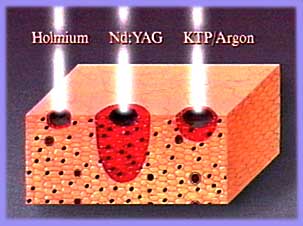Why is it better?
In the specific case of the spine and taking as example the most common condition in it as serious disc herniation, lumbar either (on the lower back) or cervical (neck), progress in recent years have been very important through the application of bio-medical engineering and the development of sophisticated machines and equipment they have with the ultimate goal of treatment of this disabling disease of the spine that causes so much trouble for the normal development of the normal activity of daily life with a diminishing aggression to operate the patient.

Classically to correct the herniated disc were proceeding to open surgical intervention, known as laminectomy, but given that this technique entailed many disadvantages for some patients began to appear percutaneous (ie through the skin, through a small hole). First came the chemo (nucleolysis of percutaneous lumbar discs-Choy-New.Engl.J.Med), which was injected into the intervertebral disc to disc herniation had a substance capable of destroying the disc tissue, it brought some problems since the extent of disk destruction could not be controlled accurately and was abandoned.
Then came the open disc surgery with a microscope, equal to the laminectomy wound but smaller, produced less instability but could produce classical laminectomy as the "epidural fibrosis, is still practiced, but less than before.
Then came the Percutaneous Discectomy (chirurgie percutanne the herniated disk lumbaire-camille roy, Benazet - Saillant. Enciclop. Med-chirurgicale. Paris) or removal of the herniated disc through a small hole in the skin, and instruments were introduced Very fine without touching the column and thus achieve remove the damaged disc tissue without eliminating completely the disk and reducing intradiscal pressure, this crucial element in the genesis of the herniated disk. This technique does not produce fibrosis, and destabilizes the spine without the use of plates, screws, hospitalization (since it is ambulatory) and is performed without general anesthesia. Moreover, its cost is infinitely lower than the other techniques.
Currently, it has resorted to the treatment of herniated discs by using the Holmium laser or "laser touch" (The ablation capacity of holmium-Yag laser in lumbar discs interverbral-Leu et coll-Zurich-Switzerland), This technique can be summarized as follows: to be inserted percutaneously a cannula, less thick than a plastic pen spare parts, which includes a laser fiber, a micro-TV camera, and irrigation hoses aspiration, besides having a mechanism to mobilize the tip of the fiber laser according to the requirements of the surgeon, thus allowing you to have precise control over the instrument.
Once inside, the surgeon will explore within the affected disc through the video system, which gives a clear vision of what the problem exactly. Applying the laser, the surgeon disintegrates damaged portions of the affected intervertebral disc, thereby reducing the disc pressure, providing immediate relief to the patient who is on the operating table.
Thanks to the irrigation system of serum this type of instrument, further ensures that the laser beam will never affect beyond that required by the surgeon, because the liquid medium that is created within the intervertebral disc maintains in a correct range intradiscal temperature.
This wonderful technology, which in turn seems out of a science fiction story, is the State-Of-The-Art Current of medicine in developed countries.
- Other interesting facts about the Holmium-Yag laser:
We mention that this "laser touch" can coagulate in liquid medium without producing nerve stimulation. Furthermore, the temperature elevation at the intervertebral discs is: 10 degrees Celsius in the nucleus, 1 degree Celsius in the subsequent common vertebral ligament and 4 degrees Celsius over the endplates. (Ablation rates and temperatures profile of holmium-Yag laser ablation of intervertebral discs-Kutschers. Nneuchatel-Suisse), temperature these to ensure a range of patient safety never before achieved by any other type of laser.
 Preliminary studies showed that the American school of surgery of herniated discs with this type of laser or Holmium-Yag contact did not evidence any serious complications, minimal aggression, simplicity of procedure, vaporizing 51% of the initial intradiscal pressure without loss of the preservation of disc height with center of rotation of the spine and the consequent preservation of spinal stability. All this has led to excellent results statistics for percutaneous lumbar discectomy have gone from 87% to 92% for the American school. (results of percutaneous lumbar discectomy with laser-sherk et coll-state of the art reviews-spine).
Preliminary studies showed that the American school of surgery of herniated discs with this type of laser or Holmium-Yag contact did not evidence any serious complications, minimal aggression, simplicity of procedure, vaporizing 51% of the initial intradiscal pressure without loss of the preservation of disc height with center of rotation of the spine and the consequent preservation of spinal stability. All this has led to excellent results statistics for percutaneous lumbar discectomy have gone from 87% to 92% for the American school. (results of percutaneous lumbar discectomy with laser-sherk et coll-state of the art reviews-spine).
What is more important the Holmium-Yag opens endoscopic exploration routes within the spinal canal with the potential to remove the epidural fibrosis through peri-duroscopia and foraminoscopias and research.
- A step forward in South America.
 Until very recently there was no device Holmium-Yag laser in South America, but thanks to an initiative of the Center for Percutaneous Discectomy, by the Dr.Salim Daher Ramos, was commissioning Unit Percutaneous Laser Surgery of the Spine, which has a sophisticated device which represents the highest technology in surgical laser Holmium Yag, thus ensuring the welfare of the community, not only here in Venezuela, but throughout South America.
Until very recently there was no device Holmium-Yag laser in South America, but thanks to an initiative of the Center for Percutaneous Discectomy, by the Dr.Salim Daher Ramos, was commissioning Unit Percutaneous Laser Surgery of the Spine, which has a sophisticated device which represents the highest technology in surgical laser Holmium Yag, thus ensuring the welfare of the community, not only here in Venezuela, but throughout South America.





